(新课标)Unit 6 Section A 3a-3c 课件+内嵌音频 (新目标七下 Unit 6 I am watching TV.)
文档属性
| 名称 | (新课标)Unit 6 Section A 3a-3c 课件+内嵌音频 (新目标七下 Unit 6 I am watching TV.) | 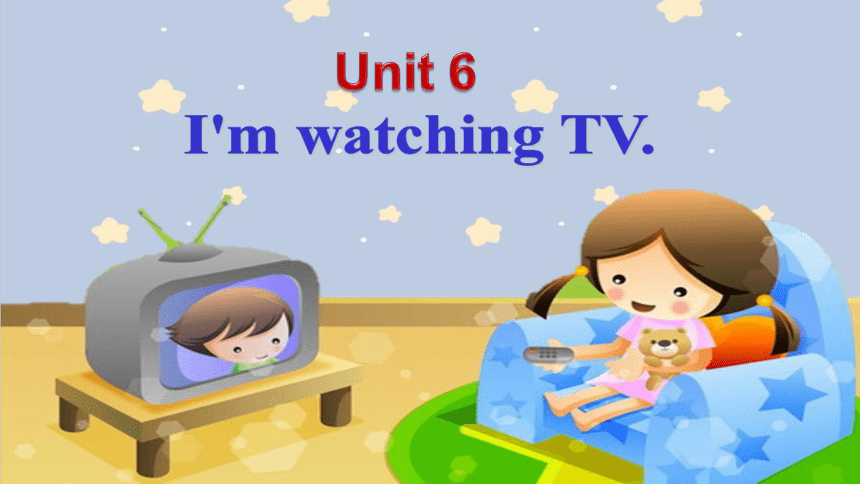 | |
| 格式 | pptx | ||
| 文件大小 | 18.9MB | ||
| 资源类型 | 试卷 | ||
| 版本资源 | 人教新目标(Go for it)版 | ||
| 科目 | 英语 | ||
| 更新时间 | 2024-04-13 11:32:59 | ||
图片预览


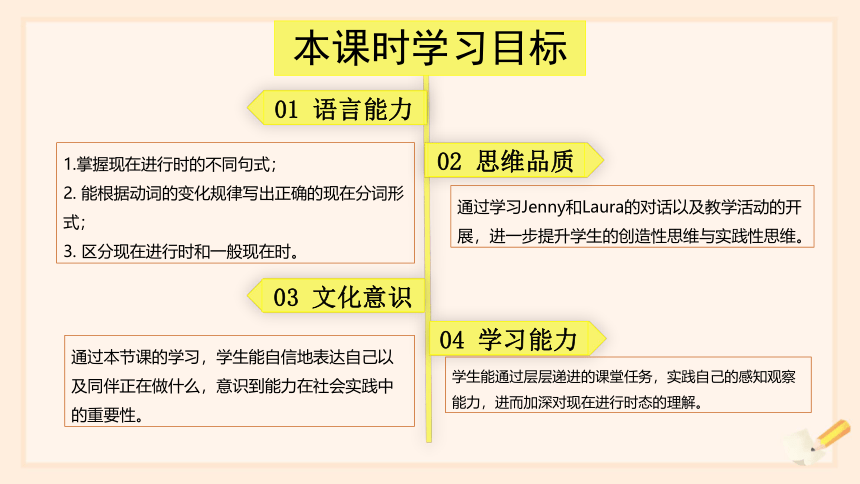
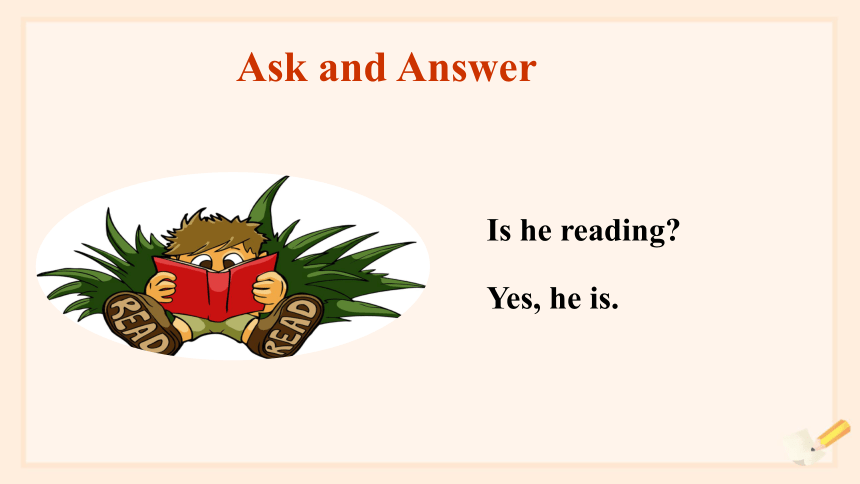
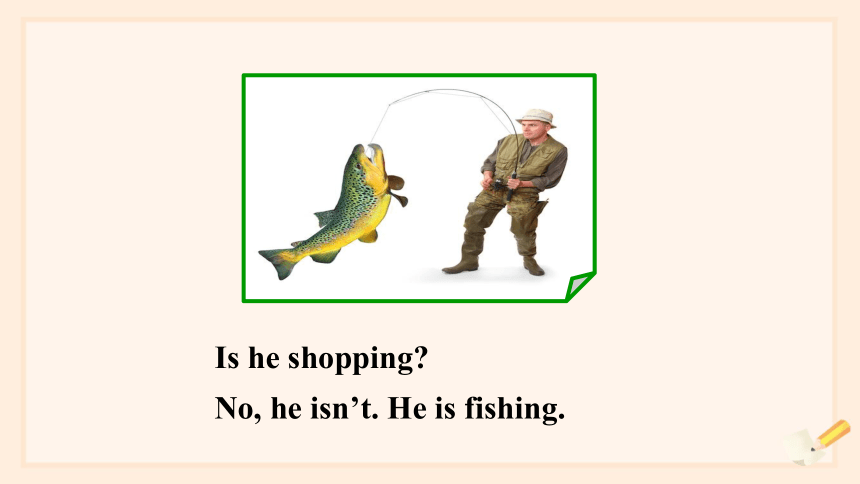

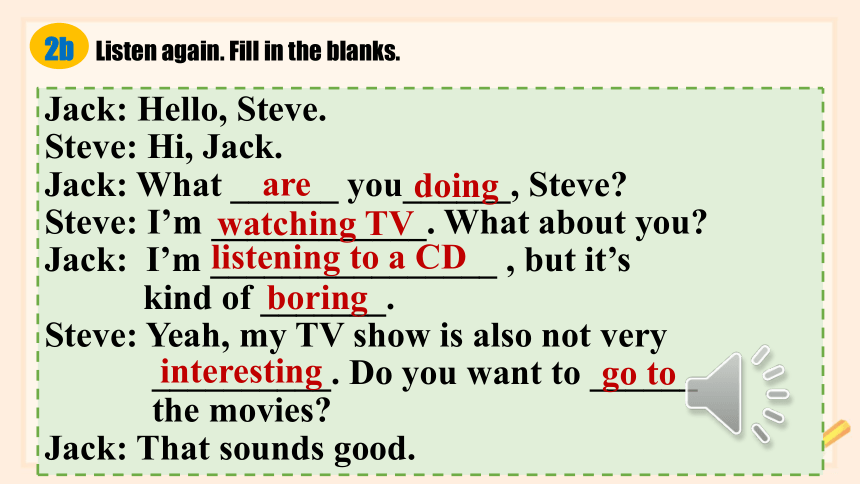
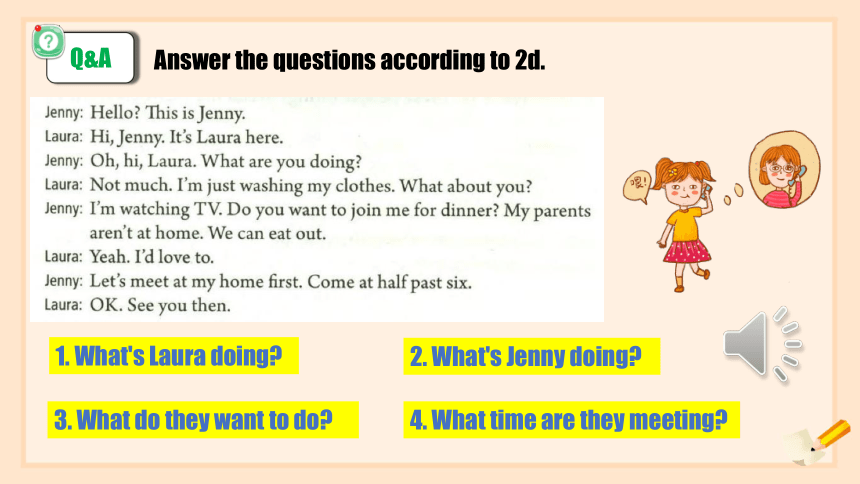
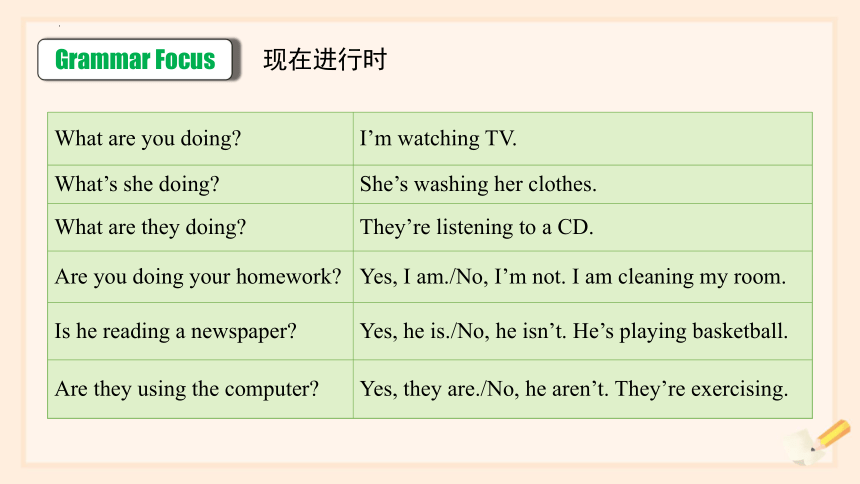
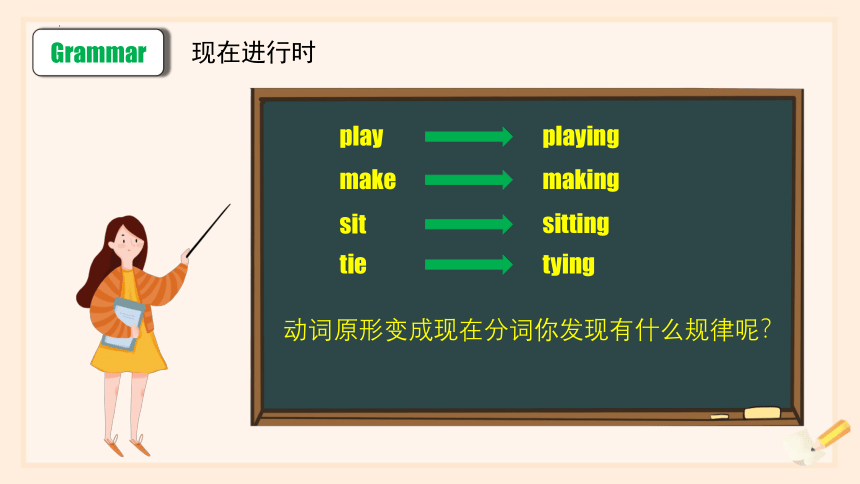
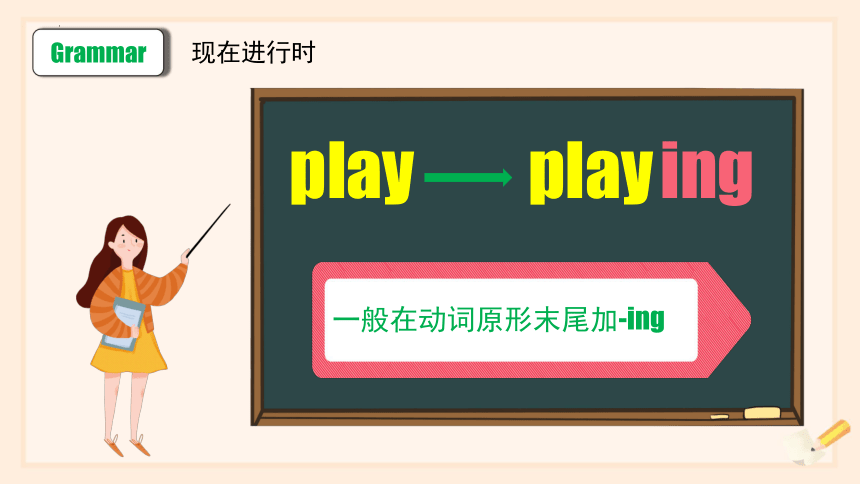
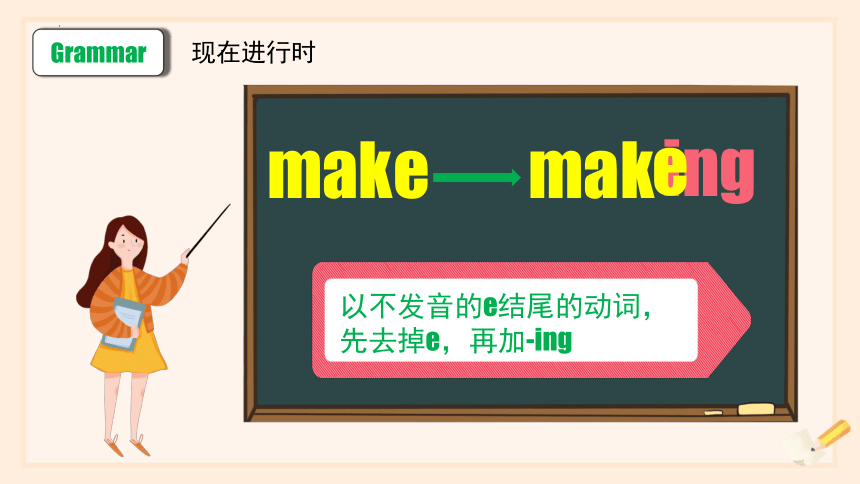
文档简介
(共43张PPT)
Section A
3a-3c
本课时学习目标
01 语言能力
02 思维品质
03 文化意识
04 学习能力
1.掌握现在进行时的不同句式;
2. 能根据动词的变化规律写出正确的现在分词形式;
3. 区分现在进行时和一般现在时。
通过学习Jenny和Laura的对话以及教学活动的开展,进一步提升学生的创造性思维与实践性思维。
通过本节课的学习,学生能自信地表达自己以及同伴正在做什么,意识到能力在社会实践中的重要性。
学生能通过层层递进的课堂任务,实践自己的感知观察能力,进而加深对现在进行时态的理解。
Ask and Answer
Is he reading
Yes, he is.
Is he shopping
No, he isn’t. He is fishing.
Are they playing football
No, they aren’t. They are playing basketball.
2b
Listen again. Fill in the blanks.
Jack: Hello, Steve.
Steve: Hi, Jack.
Jack: What ______ you______, Steve
Steve: I’m ____________. What about you
Jack: I’m ________________ , but it’s
kind of _______.
Steve: Yeah, my TV show is also not very
__________. Do you want to ______
the movies
Jack: That sounds good.
are
doing
watching TV
listening to a CD
boring
interesting
go to
Answer the questions according to 2d.
Q&A
1. What's Laura doing
2. What's Jenny doing
3. What do they want to do
4. What time are they meeting
Grammar Focus
What are you doing I’m watching TV.
What’s she doing She’s washing her clothes.
What are they doing They’re listening to a CD.
Are you doing your homework Yes, I am./No, I’m not. I am cleaning my room.
Is he reading a newspaper Yes, he is./No, he isn’t. He’s playing basketball.
Are they using the computer Yes, they are./No, he aren’t. They’re exercising.
现在进行时
现在进行时
Grammar
play
playing
make
making
sit
sitting
tie
tying
动词原形变成现在分词你发现有什么规律呢?
现在进行时
Grammar
play
play
ing
一般在动词原形末尾加-ing
现在进行时
Grammar
make
mak
ing
以不发音的e结尾的动词,先去掉e,再加-ing
e
现在进行时
Grammar
sit
sit
ing
以重读闭音节结尾的动词,如果末尾只有一个辅音字母,应先双写这个字母,再加-ing
t
现在进行时
Grammar
tie
t
ying
少数以ie结尾的动词,变ie为y再加-ing
ie
live
liveing
liviing
living
选择动词的现在分词形式
stop
stopping
stoppin
stoping
选择动词的现在分词形式
write
writeing
writing
writting
选择动词的现在分词形式
肯定句式: 主+ ______________________+其他.
否定句式: 主+am/is/are+ ______+doing+其他.
疑问句式:__________+主+doing+其他?
特殊疑问句式:What+ ___________+主+ _______+其他?
be (am/is/are) + doing
not
Am/Is/Are
am/is/are
doing
现在进行时的句式结构
Grammar
1. Linda is studying in the room.
2. They are learning English.
1. I’m not watching TV.
2. He isn’t playing the piano.
1. Are you cleaning the room
2. Is Tom playing basketball
1. What is your mother doing
2. What are you doing
is not=isn’t are not=aren’t
Grammar Focus
She’s exercising (now).
She exercises (on Mondays/every night/ in the mornings/etc.).
现在进行时
现在进行时 V.S. 一般现在时
一般现在时
表示通常性、规律性、习惯性、真理性(即事实)的动作或状态,或者动作有时间规律发生的事件的一种时间状态。
现在进行时既可以表示说话时正在进行或发生的动作,也可表示当前一段时间内的活动或现阶段正在进行的动作。
不同的时间状语
Tom often _____ TV on Saturday evenings, but now he is _____ stories.
looks; reading
watching; reads
练习
①
watches; reading
watches; looking
—What class is he _______ now
—Biology. He _______ a biology class three times a week.
having; has
have; have
练习
②
having; has
having; have
3a
Write sentences following the examples.
1. Jenny/ clean the house/ now
__________________________________
2. Bob/ make dinner/every Saturday
___________________________________
3. Mary’s parents/ drink tea/after dinner
____________________________________
4. Bill/ talk on the phone/now
____________________________________
5. Becky and Bob/ watch TV/on weekends
_____________________________________
Jenny is cleaning the house now.
Bob makes dinner every Saturday.
Mary’s parents drink tea after dinner.
Bill is talking on the phone now.
Becky and Bob watch TV on weekends.
drink tea 喝茶
3b
Number the sentences in order to make a telephone conversation. Then practice it with a partner.
_______ Do you want to go tomorrow then
_______ OK. See you tomorrow evening!
_______ I’m reading a book.
_______ Let’s go at seven o’clock.
_______ No, this book is really interesting.
_______ What are you doing
_______ Do you want to go to the movies now
_______ Sure, what time
1
2
3
4
5
6
7
8
What are you doing
I’m reading a book.
Do you want to go to the movies now
No, this book is really interesting.
Do you want to go tomorrow then
Sure, what time
Let’s go at seven o’clock.
OK. See you tomorrow evening!
3c
Take turns miming different activities in your group. The others in the group guess what the activities are.
talk on the phone
clean
read a newspaper
watch TV
listen to a CD
make soup
exercise
wash the dishes
use the computer
1
This is Jenny. 我是珍妮。
现在进行时:表示说话瞬间正在进行或发生的动作。
现在进行时的构成: am / is / are +
This is … (speaking).是电话用语,意为“我是……”。在英语中,打电话时习惯用 this 表示“我”,用that表示对方,而不用I和 you。
-Is that Jim speaking
-Yes, this is Jim speaking.
-May I speak to Peter
-This is Peter.
This is
现在进行时:表示说话瞬间正在进行或发生的动作。
现在进行时的构成: am / is / are +
电话用语
Is that … (speaking)
你是……吗?
This is … (speaking)
我是……
Hold on, please.
请等一下。
Who’s that (speaking)
你是谁?
I’ll call sb. back later.
我过会给某人回电话。
May/Could I speak to…
请……接电话好吗?
1
This is Jenny. 我是珍妮。
This is
2
I’d love to. 我很乐意。
现在进行时:表示说话瞬间正在进行或发生的动作。
现在进行时的构成: am / is / are +
I’d love to.相当于I’d like to.,用来表示愉快地答应对方的请求、提议或邀请,意为“我很想/愿意”。其中I’d是I would 的缩写形式。
-Will you go for a walk with me 你和我一起去散步好吗?
-Yes, I’d love/like to. 好的,我很愿意去。
【拓展】当委婉拒绝他人的邀请时,多用“I’d love to, but... ”或“ Sorry, I’m afraid I can’t because...”等。
-Would you like to go swimming with me 你想要和我去游泳吗
-I'd love to , but I have to do my homework. 我很想去,但是我必须做作业。
1
—Where is your brother
—He _____ the flowers in the garden.
A. water B. waters C. is watering D. watering
— ______ to the school library every day
—No, but now I ______ in the school library.
A. Do you go, am reading B. Are you going, read
C. Do you go, read D. Do you go, am not reading
2
Exercise
单项选择。
1. Please don’t make so much noise. The baby __________ (sleep) now.
2. Jimmy’s mother ______ (do) the housework every week.
3. Look! Ken and Tom ______________ (study) in the classroom.
4. My brother usually _______ (clean) his classroom after school. But now he ___________ (play) basketball.
5. My father usually ______ (read) newspapers in his free time.
Exercise
用单词的适当形式填空。
is sleeping
does
are studying
is playing
cleans
reads
Exercise
句型转换。
1. Does Rose run every morning (用now替换every morning改写句子)
_____ Rose ________ now
2. I’m doing my homework now. (改为一般疑问句)
________ ________ ________ ________ homework now
3. My mother is dancing with her friends. (对划线部分提问)
________ ________ your mother ________
Is
running
Are
you
doing
your
What
is
doing
Part Seven
Summary
Summary
Words and Phrases:
Wash clothes, join sb. for dinner, at home, eat out, make dinner, drink tea, play basketball, tomorrow
1
Sentences:
-Are they using the computer -Yes, they are. / -No, he aren’t.
-What are they doing -They’re listening to a CD.
2
Grammar:
1. 现在进行时的构成:am / is / are + doing
2. 现在进行时的不同句式:
①肯定句式: 主+ am/is/are + doing+其他.
②否定句式: 主+am/is/are+ not +doing+其他.
③疑问句式: Am/Is/Are +主+doing+其他
④特殊疑问句式: What+ am/is/are+主+doing+其他
3
Remember all the new words that we learned.
Finish the exercises. (A)
2. . (B)
3. . (C)
Summary
现在进行时 V.S. 一般现在时
一般现在时 现在进行时
定义 表示通常性、规律性、习惯性、真理性(即事实)的动作或状态,或者动作有时间规律发生的事件的一种时间状态。 现在进行时既可以表示说话时正在进行或发生的动作,也可表示当前一段时间内的活动或现阶段正在进行的动作。
构成 am / is / are ;do / does am / is / are + doing
时间状语 always, usually, often, sometimes, never, every day, on Sundays, in the morning/afternoon/evening等。 now, at present, at this moment, these days;另外也常通过listen, look暗示使用现在进行时。
1. Remember the sentences in the Grammar Focus.
2. Master different sentence patterns of the Present Continuous Tense and try to make 5 sentences using the tense.
3. Complete the exercises.
Homework
Section A
3a-3c
本课时学习目标
01 语言能力
02 思维品质
03 文化意识
04 学习能力
1.掌握现在进行时的不同句式;
2. 能根据动词的变化规律写出正确的现在分词形式;
3. 区分现在进行时和一般现在时。
通过学习Jenny和Laura的对话以及教学活动的开展,进一步提升学生的创造性思维与实践性思维。
通过本节课的学习,学生能自信地表达自己以及同伴正在做什么,意识到能力在社会实践中的重要性。
学生能通过层层递进的课堂任务,实践自己的感知观察能力,进而加深对现在进行时态的理解。
Ask and Answer
Is he reading
Yes, he is.
Is he shopping
No, he isn’t. He is fishing.
Are they playing football
No, they aren’t. They are playing basketball.
2b
Listen again. Fill in the blanks.
Jack: Hello, Steve.
Steve: Hi, Jack.
Jack: What ______ you______, Steve
Steve: I’m ____________. What about you
Jack: I’m ________________ , but it’s
kind of _______.
Steve: Yeah, my TV show is also not very
__________. Do you want to ______
the movies
Jack: That sounds good.
are
doing
watching TV
listening to a CD
boring
interesting
go to
Answer the questions according to 2d.
Q&A
1. What's Laura doing
2. What's Jenny doing
3. What do they want to do
4. What time are they meeting
Grammar Focus
What are you doing I’m watching TV.
What’s she doing She’s washing her clothes.
What are they doing They’re listening to a CD.
Are you doing your homework Yes, I am./No, I’m not. I am cleaning my room.
Is he reading a newspaper Yes, he is./No, he isn’t. He’s playing basketball.
Are they using the computer Yes, they are./No, he aren’t. They’re exercising.
现在进行时
现在进行时
Grammar
play
playing
make
making
sit
sitting
tie
tying
动词原形变成现在分词你发现有什么规律呢?
现在进行时
Grammar
play
play
ing
一般在动词原形末尾加-ing
现在进行时
Grammar
make
mak
ing
以不发音的e结尾的动词,先去掉e,再加-ing
e
现在进行时
Grammar
sit
sit
ing
以重读闭音节结尾的动词,如果末尾只有一个辅音字母,应先双写这个字母,再加-ing
t
现在进行时
Grammar
tie
t
ying
少数以ie结尾的动词,变ie为y再加-ing
ie
live
liveing
liviing
living
选择动词的现在分词形式
stop
stopping
stoppin
stoping
选择动词的现在分词形式
write
writeing
writing
writting
选择动词的现在分词形式
肯定句式: 主+ ______________________+其他.
否定句式: 主+am/is/are+ ______+doing+其他.
疑问句式:__________+主+doing+其他?
特殊疑问句式:What+ ___________+主+ _______+其他?
be (am/is/are) + doing
not
Am/Is/Are
am/is/are
doing
现在进行时的句式结构
Grammar
1. Linda is studying in the room.
2. They are learning English.
1. I’m not watching TV.
2. He isn’t playing the piano.
1. Are you cleaning the room
2. Is Tom playing basketball
1. What is your mother doing
2. What are you doing
is not=isn’t are not=aren’t
Grammar Focus
She’s exercising (now).
She exercises (on Mondays/every night/ in the mornings/etc.).
现在进行时
现在进行时 V.S. 一般现在时
一般现在时
表示通常性、规律性、习惯性、真理性(即事实)的动作或状态,或者动作有时间规律发生的事件的一种时间状态。
现在进行时既可以表示说话时正在进行或发生的动作,也可表示当前一段时间内的活动或现阶段正在进行的动作。
不同的时间状语
Tom often _____ TV on Saturday evenings, but now he is _____ stories.
looks; reading
watching; reads
练习
①
watches; reading
watches; looking
—What class is he _______ now
—Biology. He _______ a biology class three times a week.
having; has
have; have
练习
②
having; has
having; have
3a
Write sentences following the examples.
1. Jenny/ clean the house/ now
__________________________________
2. Bob/ make dinner/every Saturday
___________________________________
3. Mary’s parents/ drink tea/after dinner
____________________________________
4. Bill/ talk on the phone/now
____________________________________
5. Becky and Bob/ watch TV/on weekends
_____________________________________
Jenny is cleaning the house now.
Bob makes dinner every Saturday.
Mary’s parents drink tea after dinner.
Bill is talking on the phone now.
Becky and Bob watch TV on weekends.
drink tea 喝茶
3b
Number the sentences in order to make a telephone conversation. Then practice it with a partner.
_______ Do you want to go tomorrow then
_______ OK. See you tomorrow evening!
_______ I’m reading a book.
_______ Let’s go at seven o’clock.
_______ No, this book is really interesting.
_______ What are you doing
_______ Do you want to go to the movies now
_______ Sure, what time
1
2
3
4
5
6
7
8
What are you doing
I’m reading a book.
Do you want to go to the movies now
No, this book is really interesting.
Do you want to go tomorrow then
Sure, what time
Let’s go at seven o’clock.
OK. See you tomorrow evening!
3c
Take turns miming different activities in your group. The others in the group guess what the activities are.
talk on the phone
clean
read a newspaper
watch TV
listen to a CD
make soup
exercise
wash the dishes
use the computer
1
This is Jenny. 我是珍妮。
现在进行时:表示说话瞬间正在进行或发生的动作。
现在进行时的构成: am / is / are +
This is … (speaking).是电话用语,意为“我是……”。在英语中,打电话时习惯用 this 表示“我”,用that表示对方,而不用I和 you。
-Is that Jim speaking
-Yes, this is Jim speaking.
-May I speak to Peter
-This is Peter.
This is
现在进行时:表示说话瞬间正在进行或发生的动作。
现在进行时的构成: am / is / are +
电话用语
Is that … (speaking)
你是……吗?
This is … (speaking)
我是……
Hold on, please.
请等一下。
Who’s that (speaking)
你是谁?
I’ll call sb. back later.
我过会给某人回电话。
May/Could I speak to…
请……接电话好吗?
1
This is Jenny. 我是珍妮。
This is
2
I’d love to. 我很乐意。
现在进行时:表示说话瞬间正在进行或发生的动作。
现在进行时的构成: am / is / are +
I’d love to.相当于I’d like to.,用来表示愉快地答应对方的请求、提议或邀请,意为“我很想/愿意”。其中I’d是I would 的缩写形式。
-Will you go for a walk with me 你和我一起去散步好吗?
-Yes, I’d love/like to. 好的,我很愿意去。
【拓展】当委婉拒绝他人的邀请时,多用“I’d love to, but... ”或“ Sorry, I’m afraid I can’t because...”等。
-Would you like to go swimming with me 你想要和我去游泳吗
-I'd love to , but I have to do my homework. 我很想去,但是我必须做作业。
1
—Where is your brother
—He _____ the flowers in the garden.
A. water B. waters C. is watering D. watering
— ______ to the school library every day
—No, but now I ______ in the school library.
A. Do you go, am reading B. Are you going, read
C. Do you go, read D. Do you go, am not reading
2
Exercise
单项选择。
1. Please don’t make so much noise. The baby __________ (sleep) now.
2. Jimmy’s mother ______ (do) the housework every week.
3. Look! Ken and Tom ______________ (study) in the classroom.
4. My brother usually _______ (clean) his classroom after school. But now he ___________ (play) basketball.
5. My father usually ______ (read) newspapers in his free time.
Exercise
用单词的适当形式填空。
is sleeping
does
are studying
is playing
cleans
reads
Exercise
句型转换。
1. Does Rose run every morning (用now替换every morning改写句子)
_____ Rose ________ now
2. I’m doing my homework now. (改为一般疑问句)
________ ________ ________ ________ homework now
3. My mother is dancing with her friends. (对划线部分提问)
________ ________ your mother ________
Is
running
Are
you
doing
your
What
is
doing
Part Seven
Summary
Summary
Words and Phrases:
Wash clothes, join sb. for dinner, at home, eat out, make dinner, drink tea, play basketball, tomorrow
1
Sentences:
-Are they using the computer -Yes, they are. / -No, he aren’t.
-What are they doing -They’re listening to a CD.
2
Grammar:
1. 现在进行时的构成:am / is / are + doing
2. 现在进行时的不同句式:
①肯定句式: 主+ am/is/are + doing+其他.
②否定句式: 主+am/is/are+ not +doing+其他.
③疑问句式: Am/Is/Are +主+doing+其他
④特殊疑问句式: What+ am/is/are+主+doing+其他
3
Remember all the new words that we learned.
Finish the exercises. (A)
2. . (B)
3. . (C)
Summary
现在进行时 V.S. 一般现在时
一般现在时 现在进行时
定义 表示通常性、规律性、习惯性、真理性(即事实)的动作或状态,或者动作有时间规律发生的事件的一种时间状态。 现在进行时既可以表示说话时正在进行或发生的动作,也可表示当前一段时间内的活动或现阶段正在进行的动作。
构成 am / is / are ;do / does am / is / are + doing
时间状语 always, usually, often, sometimes, never, every day, on Sundays, in the morning/afternoon/evening等。 now, at present, at this moment, these days;另外也常通过listen, look暗示使用现在进行时。
1. Remember the sentences in the Grammar Focus.
2. Master different sentence patterns of the Present Continuous Tense and try to make 5 sentences using the tense.
3. Complete the exercises.
Homework
同课章节目录
- Unit 1 Can you play the guitar?
- Section A
- Section B
- Unit 2 What time do you go to school?
- Section A
- Section B
- Unit 3 How do you get to school?
- Section A
- Section B
- Unit 4 Don't eat in class.
- Section A
- Section B
- Unit 5 Why do you like pandas?
- Section A
- Section B
- Unit 6 I'm watching TV.
- Section A
- Section B
- Review of Units 1-6
- Unit 7 It's raining!
- Section A
- Section B
- Unit 8 Is there a post office near here?
- Section A
- Section B
- Unit 9 What does he look like?
- Section A
- Section B
- Unit 10 I'd like some noodles.
- Section A
- Section B
- Unit 11 How was your school trip?
- Section A
- Section B
- Unit 12 What did you do last weekend?
- Section A
- Section B
